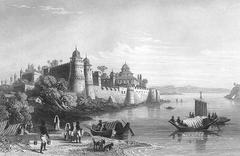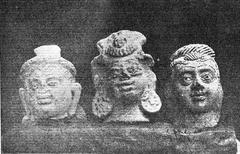Comprehensive Guide to Visiting Khusro Bagh, Prayagraj, India
Date: 16/08/2024
Introduction
Khusro Bagh, located in Prayagraj (formerly Allahabad), India, is a historical treasure trove that offers a unique glimpse into the grandeur of the Mughal era. Spanning approximately 40 acres, this garden complex, commissioned by Emperor Jahangir in the early 17th century, is home to the tombs of Prince Khusro Mirza, his mother Shah Begum, and his sister Nithar Begum. These mausoleums are not only architectural marvels but also serve as poignant reminders of the familial conflicts and political intrigues that characterized the Mughal dynasty (Travel Triangle).
The historical significance of Khusro Bagh is amplified by its rich architectural elements, including intricate stone carvings, Persian designs, and calligraphic inscriptions by Mir Abdullah Mushkin Qalam, the court calligrapher of Jahangir. The garden’s layout, influenced by Persian garden traditions, features symmetrical patterns, water features, and lush greenery, symbolizing the Mughal quest for paradise on earth (Wikipedia).
Beyond its historical and architectural allure, Khusro Bagh has inspired poets, writers, and artists for centuries. Its serene ambiance and cultural significance make it a cherished part of Prayagraj’s cultural landscape. Efforts are currently underway to preserve and conserve this architectural gem, ensuring that its historical significance is safeguarded for future generations (Pilgrims India).
This comprehensive guide will explore the visiting hours, ticket information, historical insights, and much more about Khusro Bagh, making it an invaluable resource for anyone planning to visit this iconic site.
Table of Contents
- Introduction
- Historical Background
- Architectural Significance
- Cultural and Historical Impact
- Preservation Efforts
- Local Legends and Folklore
- Visitor Experience
- Nearby Attractions
- Special Events and Guided Tours
- FAQ
- Conclusion
Explore Khusro Bagh: Visiting Hours, Tickets, and Historical Insights
Historical Background
Origins and Construction
Khusro Bagh was commissioned by Emperor Jahangir in memory of his eldest son, Prince Khusro Mirza. The construction of Khusro Bagh began around 1606, following the rebellion of Prince Khusro against his father, Jahangir. The garden spans approximately 40 acres and is designed in the traditional Mughal style, featuring precise stone carvings and Persian designs (Travel Triangle).
The Rebellion of Prince Khusro
Prince Khusro Mirza’s rebellion against his father in 1606 is a pivotal event in the history of Khusro Bagh. The prince’s revolt was primarily driven by his ambition to ascend the Mughal throne, a position that was eventually secured by his younger brother, Shah Jahan. The rebellion was short-lived, and Prince Khusro was captured and imprisoned by Jahangir. The garden complex, which includes Khusro’s tomb, serves as a poignant reminder of this familial conflict and the political intrigues of the Mughal dynasty (Pilgrims India).
The Mausoleums
Khusro Bagh is home to three significant mausoleums: those of Prince Khusro Mirza, his mother Shah Begum, and his sister Nithar Begum. Shah Begum, the first wife of Jahangir, committed suicide in 1604 due to the intense family strife and political turmoil. Her tomb is one of the earliest structures in the garden. Nithar Begum, Khusro’s sister, also has a mausoleum within the complex, adding to the site’s historical and emotional depth (Tour My India).
Architectural Significance
The architectural elements of Khusro Bagh are a testament to the Mughal dynasty’s patronage of art and architecture. The use of red sandstone and intricate carvings on the tombs reflect the refined aesthetic sensibilities of the Mughal era. The garden’s layout and design are influenced by Persian garden traditions, characterized by symmetrical patterns, water features, and lush greenery. These elements not only enhance the garden’s beauty but also symbolize the Mughal’s quest for paradise on earth (Wikipedia).
Calligraphic Inscriptions
One of the most striking features of the tombs in Khusro Bagh is the calligraphic inscriptions. These inscriptions, crafted by Mir Abdullah Mushkin Qalam, are a blend of Arabic and Persian scripts, showcasing the linguistic and artistic prowess of the Mughal court. The inscriptions often include verses from the Quran, poetic expressions, and dedications, adding a spiritual and emotional dimension to the architectural beauty of the tombs (Tour My India).
Frescoes and Decorative Art
The frescoes in Khusro Bagh, particularly in the tomb of Nithar Begum, are a visual delight. These wall paintings depict various themes, including floral designs, geometric patterns, and scenes from Mughal life. The use of vibrant colors and intricate detailing in the frescoes reflects the artistic excellence of the Mughal period. The decorative art in Khusro Bagh is not just limited to the frescoes but also includes carvings and inlays on the tombs, adding to the overall aesthetic appeal of the complex (The Top Tours).
The Garden Layout
The garden layout of Khusro Bagh is designed in the traditional Mughal style, with a focus on symmetry and harmony. The garden is divided into quadrants by pathways, with the tombs strategically placed within the layout. The lush greenery, flowering plants, and water features in the garden create a tranquil and serene environment, making it a perfect place for reflection and relaxation. The garden’s design not only enhances the beauty of the tombs but also provides a peaceful setting for visitors to appreciate the historical and architectural significance of Khusro Bagh (Prayag Tourism).
Cultural and Historical Impact
Khusro Bagh holds a significant place in Indian history and culture. It is not merely a historical site but a cultural treasure trove that embodies the synthesis of Indian and Persian architectural styles. The complex has inspired poets, writers, and artists throughout the centuries, influencing literary works and artistic expressions that celebrate the splendor of Mughal heritage. The garden’s serene ambiance and historical significance make it a cherished part of Prayagraj’s cultural landscape (Pilgrims India).
Preservation Efforts
Efforts are underway to preserve and conserve the architectural integrity and cultural heritage of Khusro Bagh. Restoration projects focus on maintaining the structural stability of the mausoleums, repairing intricate carvings, and ensuring the sustainability of the gardens. These conservation efforts aim to safeguard Khusro Bagh’s historical significance for future generations and promote responsible tourism practices (Pilgrims India).
Local Legends and Folklore
Khusro Bagh is steeped in local legends and folklore that add to its mystique and allure. Stories of love, betrayal, and loyalty surrounding Prince Khusro and his family members have been passed down through generations, enriching the cultural tapestry of Prayagraj. Visitors can immerse themselves in these tales while exploring the serene surroundings and marveling at the architectural splendor of the mausoleums (Pilgrims India).
Visitor Experience
Visiting Khusro Bagh offers a captivating journey through time, allowing visitors to witness firsthand the grandeur of Mughal architecture and the peaceful ambiance of its gardens. Guided tours provide insights into the historical significance of each mausoleum, the life stories of the royal occupants, and the enduring legacy of the Mughal dynasty in India’s cultural heritage. The garden’s tranquil environment makes it an ideal spot for reflection and appreciation of history (Travel Setu).
Educational Outreach
Khusro Bagh also serves as an educational resource, offering valuable lessons in history, architecture, and cultural heritage. Schools and educational institutions often organize field trips to the garden, providing students with a hands-on learning experience. The site’s historical significance and architectural beauty make it an excellent case study for those interested in Mughal history and heritage conservation (Travel Setu).
Accessibility and Visitor Information
Khusro Bagh is easily accessible from various parts of Prayagraj. The nearest airport is Prayagraj Airport (Bamrauli Airport), approximately 10 kilometers away. Prayagraj Junction railway station is just about 1 kilometer from the garden, making it convenient for visitors traveling by train. The garden is open to visitors every day from sunrise to sunset, and there is no entry fee, making it an affordable destination for all (eIndia Tourism).
Best Time to Visit
The best time to visit Khusro Bagh is during the cooler months of the year, from October to March. During these months, the temperature ranges from 10°C to 25°C, creating an ideal environment for tourists to walk around and appreciate the intricate Mughal architecture and the serene ambiance of the gardens. The weather is comfortable enough for spending long hours outdoors without the discomfort of the summer heat or the heavy monsoon rains (Travel Setu).
Travel Tips
- Dress Comfortably: Wear light and comfortable clothing, especially if you plan to visit during the warmer months.
- Stay Hydrated: Carry water bottles to stay hydrated while exploring the garden.
- Photography: Khusro Bagh is a photographer’s delight. Early mornings and late afternoons provide the best lighting for capturing the site’s beauty.
Nearby Attractions
- Anand Bhavan: A museum showcasing the Nehru family’s residence.
- Allahabad Fort: Another Mughal-era structure worth visiting.
- Sangam: The confluence of the Ganges, Yamuna, and Saraswati rivers, a significant religious site.
Special Events and Guided Tours
Khusro Bagh occasionally hosts cultural events and guided tours. Check local listings or inquire at the entrance for any scheduled events during your visit.
FAQ
Q: What are the visiting hours for Khusro Bagh? A: Khusro Bagh is open from sunrise to sunset every day.
Q: Is there an entry fee for Khusro Bagh? A: No, there is no entry fee for Khusro Bagh.
Q: Are guided tours available? A: Yes, guided tours are available and provide valuable insights into the site’s history and architecture.
Conclusion
Khusro Bagh in Prayagraj stands as a testament to the rich history and architectural grandeur of the Mughal era. Its well-preserved mausoleums of Prince Khusro Mirza, Shah Begum, and Nithar Begum offer an immersive experience into the historical and cultural narratives of the time. The garden’s intricate designs, lush greenery, and serene ambiance provide a peaceful retreat for visitors while also serving as a significant educational resource for those interested in Mughal history and heritage conservation (Travel Setu).
Efforts to preserve and maintain Khusro Bagh ensure that this historical site remains accessible and inviting for future generations. The garden’s accessibility, free entry, and the availability of guided tours make it a must-visit destination for tourists and history enthusiasts alike. Whether you are exploring the architectural marvels, enjoying a leisurely walk through the garden, or learning about the site’s historical significance, Khusro Bagh promises a unique and enriching experience (eIndia Tourism).
By visiting Khusro Bagh, you not only get to witness the splendor of Mughal architecture but also become a part of the ongoing efforts to preserve India’s rich cultural heritage. So, plan your visit, immerse yourself in history, and take away memories of one of Prayagraj’s most iconic landmarks.
References
- Travel Triangle. (n.d.). Khusro Bagh. Retrieved from Travel Triangle
- Wikipedia. (n.d.). Khusro Bagh. Retrieved from Wikipedia
- Pilgrims India. (n.d.). Cultural Heritage of Khusro Bagh in Prayagraj. Retrieved from Pilgrims India
- Travel Setu. (n.d.). Khusro Bagh Tourism. Retrieved from Travel Setu
- eIndia Tourism. (n.d.). Khusro Bagh Prayagraj. Retrieved from eIndia Tourism

